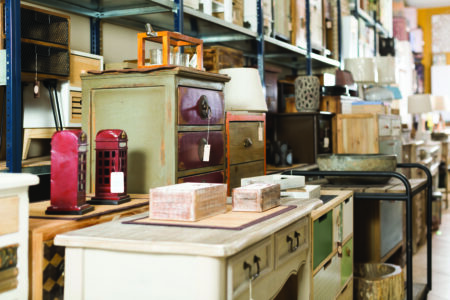How to start an antique business from home, turn a passion for antiques or vintage wares into a profitable home business pursuit, be it a full-time gig or a weekend hobby.
![]() This article is also available in audio format. Scroll down just a bit for the link and enjoy listening.
This article is also available in audio format. Scroll down just a bit for the link and enjoy listening.
If you’re looking to add an additional money-making venture to your farmstead, antique sales might be just the ticket. For many farmers, dealing in antiques is second nature. Many of us love to collect and use old machinery; we love the look and beauty of well-built antique furniture; we appreciate and use sturdily constructed equipment from yesteryear; and our kitchens are filled with gadgets that are still going strong after decades of use. For anyone who loves the pursuit and collection of vintage or unusual things, moving into the sale of such items is a natural next step.
While taking a weekend drive to go “antiquing” or “junking” at small shops scattered throughout the countryside isn’t as popular as it was 30 or 40 years ago, many people still love to explore antique stores. Online antique sales are common now, but there’s also a large segment of collectors who prefer the physical search. Often, collectors of vintage primitives and high-end antiques – who know how to spot the differences between reproductions and originals – enjoy the hands-on approach, because it gives them the ability to physically examine an item.
Audio Version
If you already sell produce, eggs, baked goods, or seasonal offerings, adding a shed or barn filled with antique treasures is one way to attract repeat customers, as well as make a little extra money.

Business Considerations
Before diving into antique sales, take time to think over the following components and develop a business plan.
One of the first things you’ll need to decide is how much time you want to dedicate to your business. If you don’t want to give up other pursuits, determine how antique sales will best fit into your existing schedule. Will your business be year-round, or seasonal? Will you be open every day, or just on the weekends? Do you want to run a shop with regular hours, or would you prefer to do two or three large, highly advertised barn sales throughout the year?
Once you have an idea of the scale of your business, you’ll need to look into the legality of operating a home-based business in your area. Restrictions and requirements vary by location, and may depend on whether you’re selling regularly or only once or twice a year. Check with your local zoning board and your local U.S. Small Business Administration office or similar organization for information regarding your location.
You’ll next need to decide where to locate your business. With at-home sales, your overhead costs will likely be less than if you rent or buy a space, but you may need to invest money into an existing building on your property to get it customer-ready. This includes making sure the sales and parking areas are accessible for all customers, and that you comply with applicable requirements established by the Americans with Disabilities Act.
You’ll also want to check into liability insurance. If you already conduct sales on your property, your existing insurance may include liability. Check with your insurance agent to make sure you’re covered.

Next, find out whether you’re required to collect and remit sales taxes in your state or province. Depending on where you live, it may not be necessary to collect and remit taxes on sales held only once or twice a year. However, if you’re wanting to operate a full-time shop, you’ll likely need to obtain a seller’s permit, under which you’ll collect and remit sales tax to the governing authority, typically on a quarterly or annual basis. You’ll also want to look into a resale certificate. This will allow you to avoid paying sales taxes on inventory you buy for resale, which is beneficial, because sales tax can substantially cut into your gross profit margin.
Finally, you’ll need to determine what your markup, or profit margin, will be on inventory in order to turn a profit. Some dealers calculate a markup of two or three times what they paid. This is more common if they’re paying additional expenses for a storefront, such as rent and utilities. By selling from your own property, you may be able to operate with a lower markup. When calculating markup, consider that you might not get the full asking price for an item. Even if items are priced reasonably, many buyers consider negotiation to be part of the experience.
Obtaining and Maintaining Inventory
Procuring and maintaining quality inventory can be hard work. Antique items are often found in dirty, grimy condition, especially if they’re pulled from old barns or sheds. While not always the case, many items will require restoration, which you’ll need to do before offering them up for sale.
Estate sales are often a good source for inventory. Watch local ads for these sales so you know what time they’ll start. Some dealers line up hours before a sale in hopes of getting the best inventory. However, the early hours of an estate sale are often hectic, and it’s rare to strike any type of bargain during this time. As a veteran dealer, I’ve found that it works well to go a few hours after the sale starts, and then return two or three more times, thoughtfully buying inventory each time. This way, I have more time to make calculated decisions and determine profit margins. Large estates often have years of collective buildup, and rarely do these sales run out of merchandise.
By going through an estate numerous times, I often make friends with the people conducting the sale. I’ve found that by the final day of the sale, these people are usually thrilled to have someone offer to take the remaining contents off their hands. I’ve bought the entire remains of some beautiful estates for as little as $20. Usually, an offer of $100 to $200 will get you a truckload of merchandise. These clean-outs often include antique glassware, vintage wedding china, old knickknacks, kitchen items, furniture, antique embroidered linens, and everything in the sheds and rafters of a barn or garage. Often, the rafters and dusty back corners hold valuable finds, such as furniture, mirrors, vintage tools, and boxes filled with forgotten treasure – items that have likely been there for years. These cleanouts commonly generate a markup of 5 to 10 times what was paid for the entire load; they’re well-worth the time and effort.

Auctions are another great source for inventory, but you’ll need to approach them with some established goals. Most auctions go in peaks and valleys on price. With larger items, you’ll have to estimate the minimum price you’d get when reselling the item. Then, you’ll need to calculate the maximum price you can pay at the auction and still make a profit on that item. Don’t get caught up in the momentum. If you can score the piece for that predetermined price or less, buy it. If it goes above your buying limit, stop bidding and wait for the next piece. Auctions typically have “price lulls,” when the auctioneer loses the crowd for a few minutes. Watch for these opportunities to get a good deal. Also, pay attention to box lots. Often filled with junk, these boxes may also contain one or two buried treasures. Check box lots carefully prior to the start of an auction.
When buying inventory, don’t forget to check out other dealers. Within the trade, a 10 percent discount to another dealer is standard courtesy. In some areas of the country, a 20 percent discount is common. Years ago, because of the way we bought our merchandise, my wife and I gave dealers discounts of up to 50 percent. We ended up with a regular book of dealers who frequented our shop and routinely bought from us. Eventually, more than half of our weekly sales were to other dealers. We never focused on the book value of an item with these sales. If we could make a little profit, and the other dealer could make a reasonable profit, and the other dealer’s customers were happy, we knew we’d be happy. Dealers weren’t competition to us; rather, they became our friends and repeat customers.

Regardless of where you find inventory, be realistic about how much you can profit from an item before you purchase it. There’s an old adage in the cattle industry: “You don’t make money when you sell, you make money when you buy.” It’s often the same in the antiques business. If you overpay for an item, there’s a good chance you’ll never recoup your money. All merchants, whether retail or wholesale, make occasional mistakes in this area – it’s just part of business. However, try to limit these mistakes. Losing money on too many items can impede your profits for an entire year.
Final Thoughts
As with any business, there will be ups and downs. Owning and operating an antiques business can be a labor of love and may require extra work, but it’s also a way to earn a little extra cash, make repeat customers for other operations, and live the country life to its fullest. If you already enjoy the pursuit, collection, and use of timeless items, an antiques business might be the right fit for you.
Doug Ottinger lives in northwest Minnesota. He has 40-plus years of experience keeping and raising various kinds of poultry. He holds a bachelor’s degree in general agriculture, with an emphasis in poultry genetics and breeding. He also has experience in commercial and small-scale hobby production.







